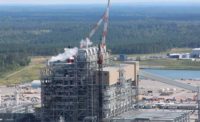Utility Southern Co.’s costly effort to produce clean energy from coal met a major milestone on Oct. 12, when its Kemper County, Miss., integrated gasification combined-cycle plant produced the first kilowatt of electricity with synthetic fuel made from local lignite. But key operational, financial, regulatory and legal hurdles remain before the $6.9-billion project—more than two years behind schedule and some $5 billion over its original cost estimate—begins to function commercially.
The highly touted facility converts the lignite to synthesis gas using two gasifiers that, in turn, will fire two combustion turbines to produce 582 MW. The plant uses a high-efficiency design developed by Atlanta-based Southern, which also extracts carbon dioxide and other pollutants. The initial electricity was produced by a mix of the synthesis gas and natural gas. The next steps include producing power with only syngas and the restart of the second gasifier.
If the milestones are not achieved by the end of October, the Kemper plant’s expected Nov. 30 in-service date and related cost estimate may require further revision, said Southern and affiliate Mississippi Power in a U.S. Securities and Exchange Commission filing. The filing said any extension beyond Nov. 30 would result in additional monthly base costs of about $25 million to $35 million.
Since May, the SEC has had a probe into the project’s cost rise and operational issues, and numerous ratepayer suits are underway. The cost overruns also were a factor in two ratings firms’ downgrades of the utility’s credit rating this year and prompted an 11-member statewide energy cooperative to halt plans in 2015 to buy a 15% interest in the plant. Construction has been overseen by the utility’s oversight affiliate Southern Co. Services. A joint venture of KBR and Yates Construction had been replaced in 2012.
Production of electricity using only syngas by the plant’s combustion turbines and the complete integration of the project’s systems must be complete before full commercial operations, said Jack Bonnikson, a Mississippi Power spokesman.
Higher costs also extend to operations and maintenance. The current O&M estimate for the first five years of operation has risen by $1 billion or more a year, according to the utility. Estimated maintenance capital costs also increased to $38.6 million from $5.4 million in year one. Increased maintenance costs were driven by the added need for equipment and materials, plant manager Bruce
Harrington said in testimony before the Mississippi Public Service Commission. The increased use of third-party contractors also played a role in the escalating costs, he said. Plant functions, such as nitrogen generation and wastewater treatment, have been outsourced.
Ramping up the plant to its maximum availability of hours of operation on syngas will take more time than originally expected, according to Harrington. It was initially expected to be 59% available in the first year, but that has decreased to 35%. By the fifth year, the plant is expected to reach 75% availability, compared with the 85% that was expected. “The extra maintenance cost is noteworthy but not all that surprising given the cutting-edge technology,” said Paul Patterson, an analyst with Glenrock Associates. The final cost of running the plant will take time due to the ramp-up rate, he said.
Once the plant is fully operational, the commission will begin hearings to determine whether it can run reliably and keep power rates reasonable. It also will determine whether Southern or its ratepayers will be responsible for the added cost, according to Mississippi Today, a local online publication.






Post a comment to this article
Report Abusive Comment